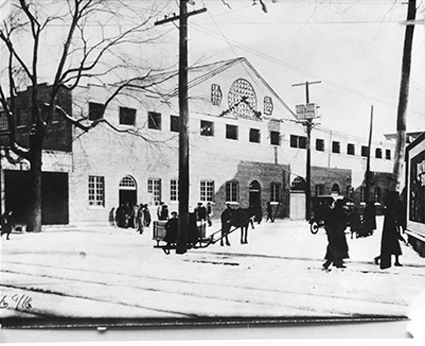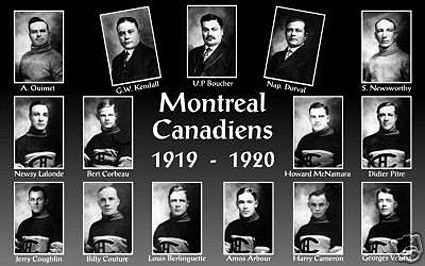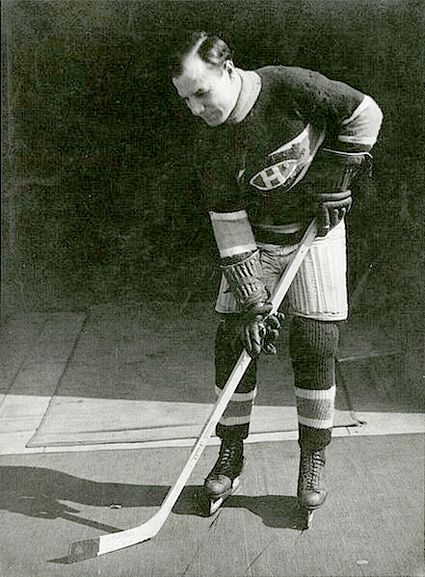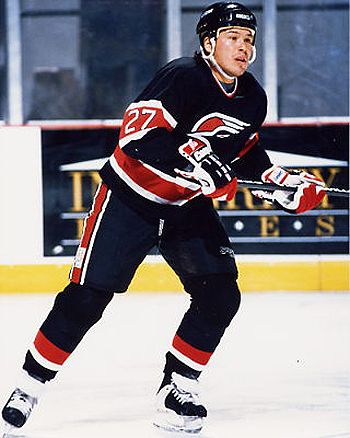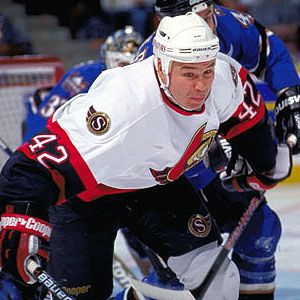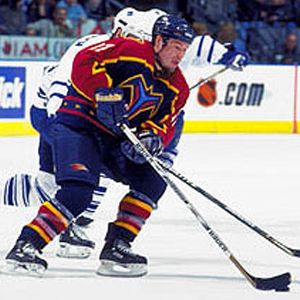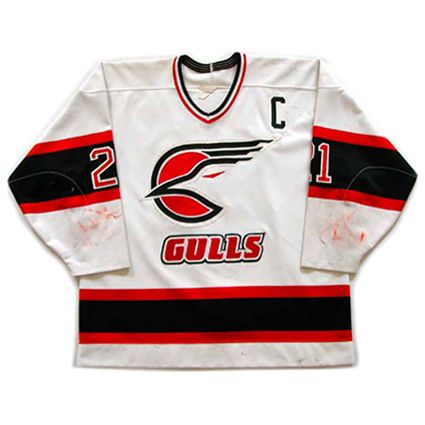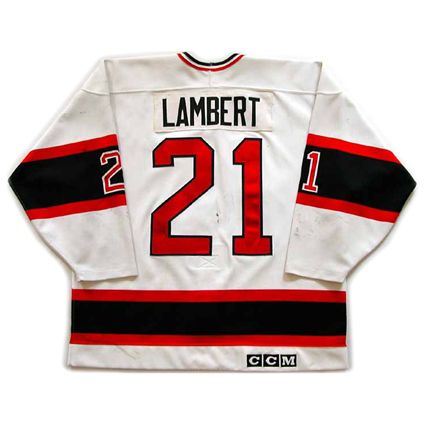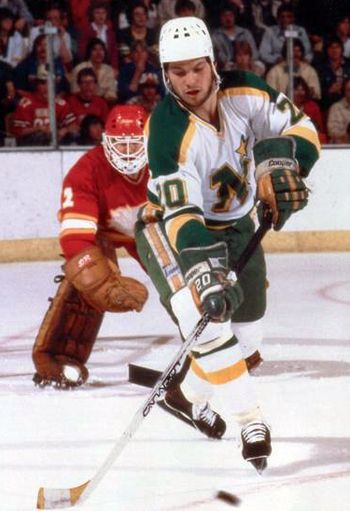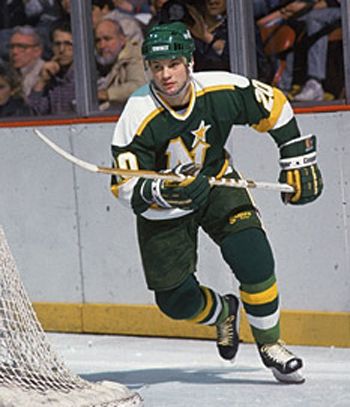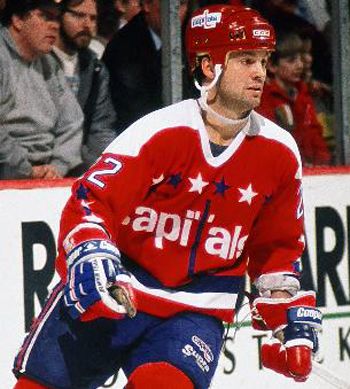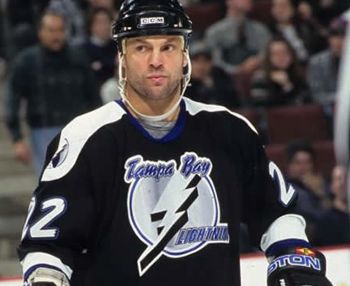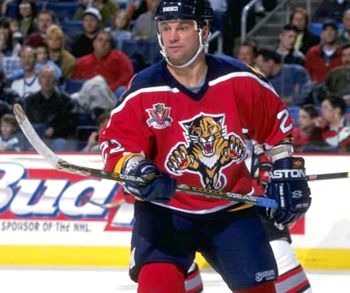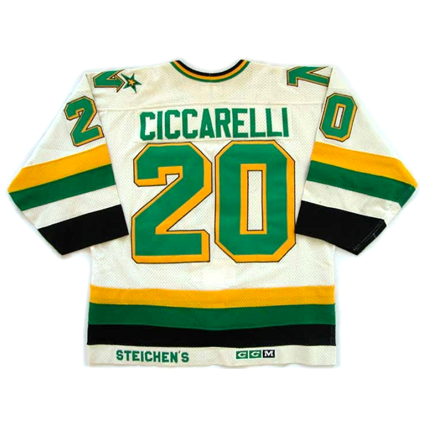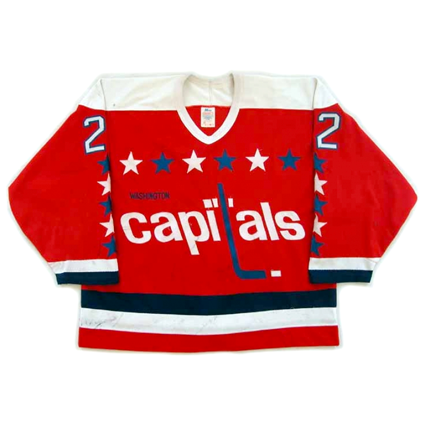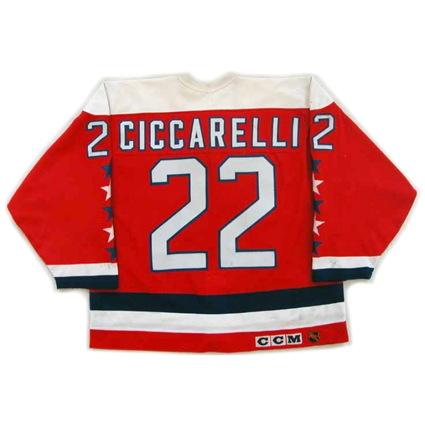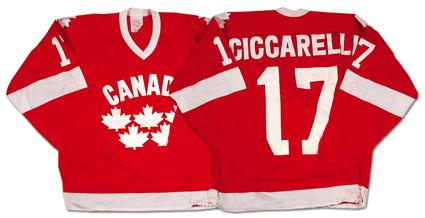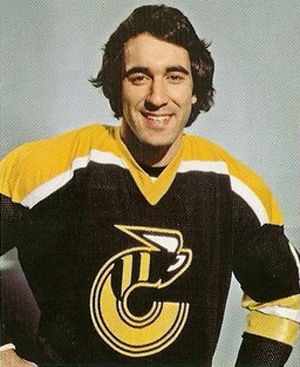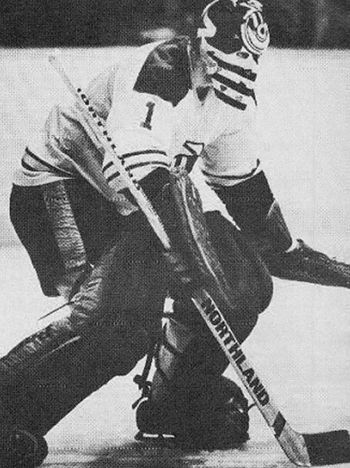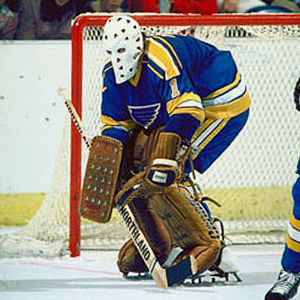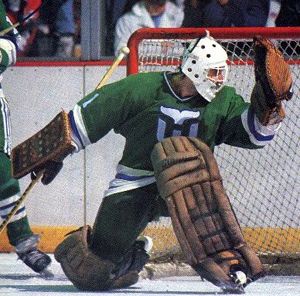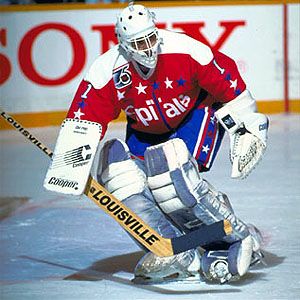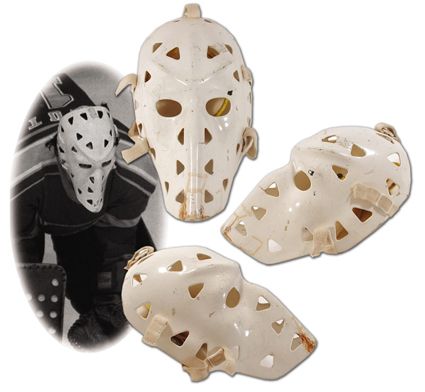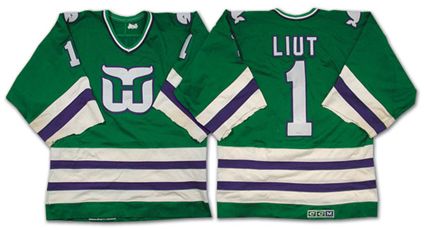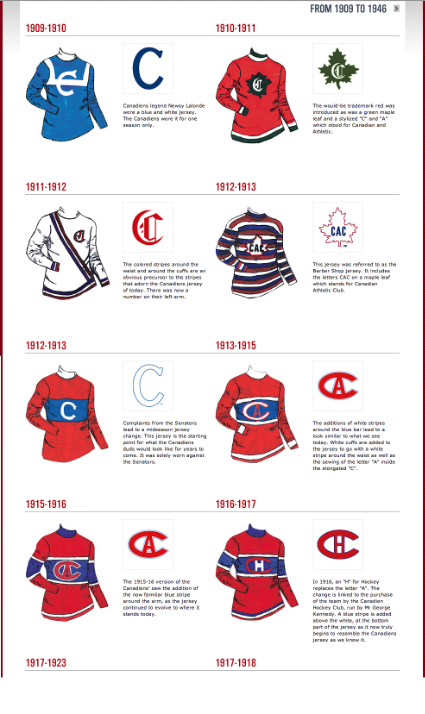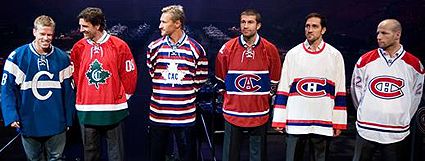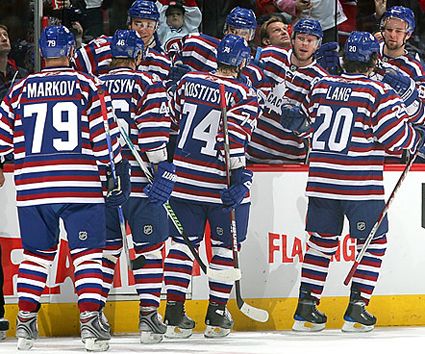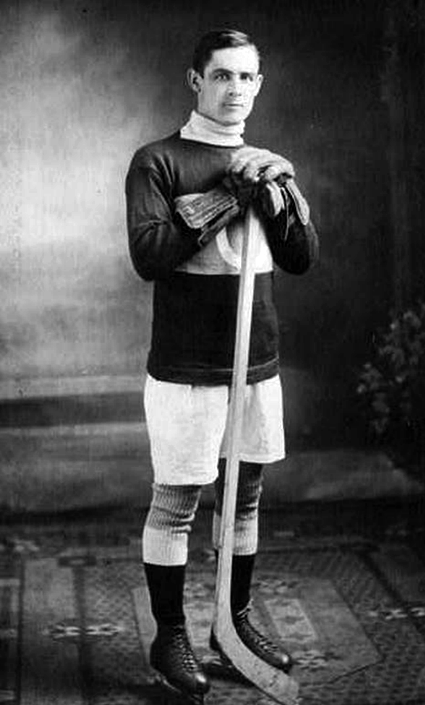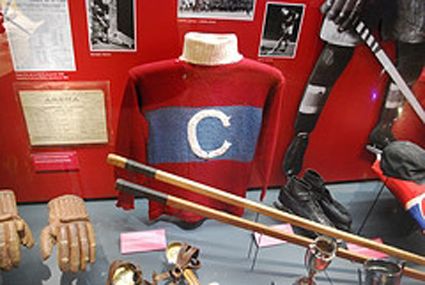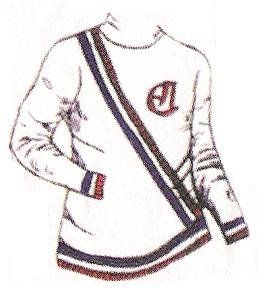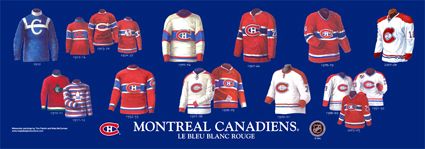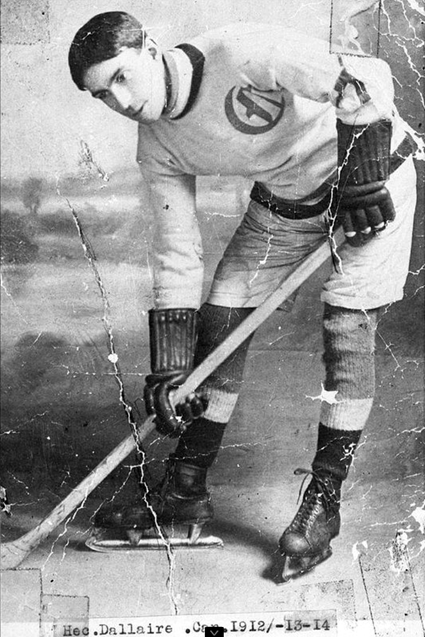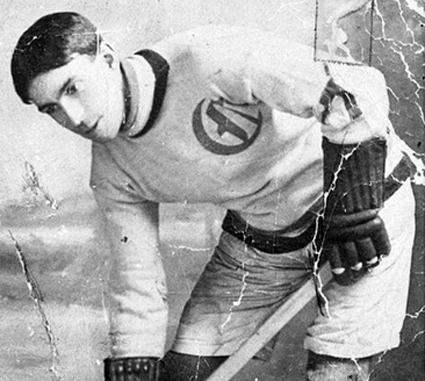Friday, January 10, 2014
1918-19 Montreal Canadiens Newsy Lalonde Jersey
It was on this date in 1920 that the Montreal Canadiens hosted the Toronto St. Patricks in the first game ever played at the Mount Royal Arena. Construction of the arena was not actually fully completed in time for the game that evening, which caused 1,000 fans to be turned away due to a lack of seating.
The Mount Royal Arena
The arena could hold 6,000 seated fans and another 4,000 standing room patrons. When the Canadiens previous home, the Jubilee Arena, burned down in the summer of 1919, The Mount Royal Arena was hastily constructed and a week after it's opening, parts of a balcony broke prior to a game with the Ottawa Senators causing the Montreal police to limit ticket sales to 6,500.
The arena suffered from not having any mechanical means of ice making and eventually the Canadiens moved to their new home, the Montreal Forum in 1926. The Mount Royal Arena became an auditorium following the departure of the Canadiens and later into a commercial building, which stood for 80 years until it too was destroyed by fire on February 29, 2000.
The 1919-20 Montreal Canadiens
When the fans of the Canadiens entered the brand new arena for the first time in 1920, they were aware that they were there to witness a bit of history with the first game at the new rink, but little did they realize a larger piece of hockey history which would unfold that evening.
The Canadiens entered the game with a 1-3 record, having scored just four goals in their previous three games, one of which was moved from Montreal to Ottawa when the Mount Royal Arena was not ready in time to begin the season. In fact, that night's eventual opening game against the St. Patricks had already been delayed twice due to not having adequate ice.
Didier Pitre opened the scoring with his first goal of the season at exactly 4:00. Newsy Lalonde struck next for Montreal exactly one minute later before adding his seventh goal of the season two minutes after his sixth.
It was Pitre's turn again to put a puck behind the St. Patricks goaltender Ivan "Mike" Mitchell just 40 seconds after Lalonde's second goal.
At the nine minute mark, Pitre completed his hat trick, chasing Mitchell from the Toronto net for good.
Billy Coutu welcomed the new St. Patricks goalie Howard Lockhart to the game with his first goal of the season at 13:30 before Odie Cleghorn extended the Canadiens lead to 7-0 at the 16 minute mark. Mickey Roach got the St. Patricks on the board with the first puck to get by Georges Vezina in goal for Montreal at 16:50. The period ended without any further scoring, leaving the Canadiens with a six goal lead after just 20 minutes of play.
Montreal's Cleghorn got the second period scoring underway four minutes in, his second of the game, followed by Lalonde completing his hat trick a minute and a half later. The St. Patricks fought back with two goals in a minute, Reg Noble scoring at 6:20 and Corbett Denneny at 7:20 to cut the Montreal lead back to 9-3.
Lalonde continued his dominant performance with back to back goals, his fourth and fifth of the game, at 9:00 and 10:30 to push Montreal into double digits on the scoreboard, now at 11.
Toronto closed out the second period scoring when Denneny got his second of the period past Vezina at the 11 minute mark, meaning the two clubs actually went nine full minutes without a goal during the second half of the period!
Cully Wilson got the scoreboard spinning once more just 30 seconds into the third period followed by Bert Corbeau joining the ranks of goal scorers on the night at 1:50.
The star of the evening Lalonde then established an NHL record with his sixth goal of the game 3:50. The St. Patricks Noble scored a pair of goals at 9:50 and 12:20 to join the parade of hat tricks and finally, even mercifully, the Canadiens Cleghorn closed out the scoring when he became the fourth player of the game to register a hat trick with his third goal of the game at 14:50, the ninth of the game against Lockhart, who took the loss.
Vezina got the win in the net for Montreal despite giving up seven goals.
The final score of 14-7 on the memorable opening night of the Mount Royal Arena set an NHL record of 21 combined goals which still stands today. Imagine the reaction of the 1,000 fans who were turned away when they learned of Lalonde's record performance and the new league mark for the greatest number of goals in a game!
It would take the high flying Edmonton Oilers of the 1980's to tie the record 65 years later when they defeated the Chicago Black Hawks 12-9 on December 11, 1985.
Today's featured jersey is a 1918-19 Montreal Canadiens Newsy Lalonde jersey. Lalonde would finish the season with 37 goals in 23 games. He added nine assists for 46 points to come second in the scoring race to Quebec's Joe Malone and his 39 goals and 49 points.
The Canadiens first red sweater with a blue chest stripe appeared in 1912-13 and featured just a "C" in white and was worn only against the Ottawa Senators due to the similarity between the Canadiens striped jerseys and the Senators red, black and white barberpole jerseys.
In 1913 a letter was added inside the "C", but not the familiar "H", but an "A". which would remain in use through 1916.
The "H" would appear for the first time in 1916-17. The logo then went through several subtle color and outline changes, including a red "CH" combination for 1919-20. Photos of the all red Canadiens "CH" logo from the year they helped set the single game scoring record are nearly impossible to find, and only the team collage photo above could be found after an extensive search.
The style of jersey featured today from the 1918-19 season concluded with the Canadiens competing for the rights to the 1919 Stanley Cup against the Seattle Metropolitans. The series was suspended after five games due to the Spanish Flu epidemic, which caused the remainder of the series to be cancelled and sent Lalonde, Coutu, Louis Berlinguette, Jack McDonald, Joe Hall and their manager George Kennedy to the hospital, with Hall dying of pneumonia five days later. Lalonde would fully recover and return to the Canadiens for the following season.
Today's video section shows Newsy Lalonde being honored in his hometown in Cornwall, Ontario with the naming of "Newsy Lalonde Way".
Labels:
Lalonde Newsy,
Montreal Canadiens
Thursday, January 9, 2014
1991-92 San Diego Gulls Denny Lambert Jersey
Born on this date in 1970, Denny Lambert played three seasons with the Sault Ste. Marie Greyhounds of the Ontario Hockey League from 1988-89 to 1990-91, which was his best season with 28 goals and 67 points.
Undrafted, Lambert signed with the San Diego Gulls of the International Hockey League for the 1991-92 season. He would play four seasons with the Gulls, including the Gulls finest season when they made it to the Turner Cup Finals in 1993. While with the Gulls, he would average 260 penalty minutes a season, with a high of 314 in 1993-94, third in the league by less than 10 minutes.
Lambert had a fine 1994-95 season, scoring 25 goals and 60 points, double his average from the previous three seasons, which caught the attention of the Mighty Ducks of Anaheim, who signed him for the remainder of the season, which made for a long year for Lambert, as combined he played in 88 regular season games that season, which must rank as one of the highest totals ever. Lambert scored his first NHL goal that season on his way to 4 points
He split the following season between the Baltimore Bandits of the American Hockey League and the Mighty Ducks, playing 44 games with Baltimore and 33 with Anaheim.
For the 1996-97 season, Lambert was signed by the Ottawa Senators as a free agent, playing 80 games his first season and another 72 games in 1997-98, setting a NHL high of 250 penalty minutes that season, as well as scoring a career best 9 goals.
Now established as a full-time NHLer, Lambert was chosen by the Nashville Predators in the 1998 NHL Expansion Draft, where he would play the entire 1998-99 season.
Lambert was then traded to another new expansion club, the first year Atlanta Thrashers for the 1999-00 season, where he would play for two seasons.
It was back to Anaheim for the 2001-02 season for his second stint with the Mighty Ducks. There Lambert yet again finished with between 213 and 219 penalty minutes for the fifth time in six seasons, with only his 250 minutes in 1997-98 tampering with his amazing consistency.
Lambert wrapped up his career with the Milwaukee Admirals of the AHL in 2002-03 before retiring as a player. After some time as an assistant, Lambert would become head coach of the Soo Greyhounds, his junior club, for three seasons from 2008 to 2011.
Today's featured jersey is a 1991-92 San Diego Gulls Denny Lambert jersey. This iteration of the Gulls were members of the IHL for five seasons, a team name that dates back to a previous Western Hockey League franchise which began play in the mid 1960's.
After their five seasons in San Diego, the IHL franchise relocated up the coast to become the Long Beach Ice Dogs, and were immediately replaced by a new franchise in the WHL, also known as the Gulls. Their membership would become part of the ECHL and last through 2006. Two seasons later, the San Diego Gulls name would once again resurface, now used by a Junior A team in the Western States Hockey League, now the fourth franchise to use the Gulls name in San Diego!
The Gulls stellar 1992-93 season saw them finish with a 62-12-8 record for a league record 132 points, but fell short in the finals. Notable players for the Gulls were Ron Dugay, Glen Hanlon, Charlie Simmer, Ray Whitney, Sean Burke, Lindy Ruff and IHL scoring champion Dimitri Kvartalnov.
While the Gulls history was a brief one, they left behind a legacy of attractive jerseys with classic styling and a very sharp logo.
Undrafted, Lambert signed with the San Diego Gulls of the International Hockey League for the 1991-92 season. He would play four seasons with the Gulls, including the Gulls finest season when they made it to the Turner Cup Finals in 1993. While with the Gulls, he would average 260 penalty minutes a season, with a high of 314 in 1993-94, third in the league by less than 10 minutes.
Lambert had a fine 1994-95 season, scoring 25 goals and 60 points, double his average from the previous three seasons, which caught the attention of the Mighty Ducks of Anaheim, who signed him for the remainder of the season, which made for a long year for Lambert, as combined he played in 88 regular season games that season, which must rank as one of the highest totals ever. Lambert scored his first NHL goal that season on his way to 4 points
He split the following season between the Baltimore Bandits of the American Hockey League and the Mighty Ducks, playing 44 games with Baltimore and 33 with Anaheim.
For the 1996-97 season, Lambert was signed by the Ottawa Senators as a free agent, playing 80 games his first season and another 72 games in 1997-98, setting a NHL high of 250 penalty minutes that season, as well as scoring a career best 9 goals.
Now established as a full-time NHLer, Lambert was chosen by the Nashville Predators in the 1998 NHL Expansion Draft, where he would play the entire 1998-99 season.
Lambert battles Kelly Chase while with the Predators
It was back to Anaheim for the 2001-02 season for his second stint with the Mighty Ducks. There Lambert yet again finished with between 213 and 219 penalty minutes for the fifth time in six seasons, with only his 250 minutes in 1997-98 tampering with his amazing consistency.
Lambert wrapped up his career with the Milwaukee Admirals of the AHL in 2002-03 before retiring as a player. After some time as an assistant, Lambert would become head coach of the Soo Greyhounds, his junior club, for three seasons from 2008 to 2011.
Today's featured jersey is a 1991-92 San Diego Gulls Denny Lambert jersey. This iteration of the Gulls were members of the IHL for five seasons, a team name that dates back to a previous Western Hockey League franchise which began play in the mid 1960's.
After their five seasons in San Diego, the IHL franchise relocated up the coast to become the Long Beach Ice Dogs, and were immediately replaced by a new franchise in the WHL, also known as the Gulls. Their membership would become part of the ECHL and last through 2006. Two seasons later, the San Diego Gulls name would once again resurface, now used by a Junior A team in the Western States Hockey League, now the fourth franchise to use the Gulls name in San Diego!
The Gulls stellar 1992-93 season saw them finish with a 62-12-8 record for a league record 132 points, but fell short in the finals. Notable players for the Gulls were Ron Dugay, Glen Hanlon, Charlie Simmer, Ray Whitney, Sean Burke, Lindy Ruff and IHL scoring champion Dimitri Kvartalnov.
While the Gulls history was a brief one, they left behind a legacy of attractive jerseys with classic styling and a very sharp logo.
In today's video section, Lambert does what he does best, as he throws haymakers with Paul Kruse of the Salt Lake Golden Eagles during the 1991-92 IHL season.
Labels:
IHL,
Lambert Denny,
San Diego Gulls
Wednesday, January 8, 2014
1987-88 Minnesota North Stars Dino Ciccarelli Jersey
On this date in 1994, Dino Ciccarelli of the Detroit Red Wings scored his 500th goal in a 6-3 win over the Los Angeles Kings.
After four seasons in Detroit, which included scoring his 500th goal on this date in 1994, just the 19th player in NHL history to do so, he was traded to the Tampa Bay Lightning in time for the 1996-97 season as part of a youth movement in Detroit.
The North Stars added the black trim to their white jerseys back in 1981, but did not update their green road sweaters to include black until the 1988-89 season, seven years after "toughening up" their home whites!
Here is a prime example of the kind of treatment Ciccarelli received throughout his career standing in front of the opposition's goal.
Ciccarelli was an undrafted free agent due to suffering a severely broken leg in junior hockey. The North Stars had noticed him the year before when he was too young to be eligible for the draft, so when he went through the 1979 draft with out being selected, the North Stars had him checked out by a doctor and signed him to a contract.
"I broke my femur badly enough in my second year of junior hockey that the doctors didn't give me much chance of ever being able to play professionally. I had scored 72 goals the previous season, but my injury wiped me off everyone's draft list in 1979. I wasn't going to let that stop me. I had to go through a year and a half of rehabilitation, but I was determined to do everything I could to live out my dream and play in the National Hockey League. I was totally frustrated when I recovered from the injury, scored 50 goals in my last season of junior and was passed on for the second time at the 1980 draft." recalled Ciccarelli.
"Lou Nanne of the Minnesota North Stars finally gave me an opportunity when he signed me as a free agent. He sent me to Oklahoma City to see how I'd fare in the minors. Things went well, and three-quarters of the way through the season, I was called up to Minnesota for a few games." said Ciccarelli.
After proving himself in the minors, Ciccarelli would play in 32 regular season games with the North Stars, doing quite well for a rookie scoring 18 goals and 30 points, but would really catch fire during the playoffs. Teamed with fellow rookies Neal Broten and Brad Palmer, Ciccarelli would set the rookie playoff scoring records for goals, with 14, and points, with 21, in 19 games as the North Stars would reach the Stanley Cup Finals for the first time in franchise history. Ciccarelli quickly became a fan favorite with the North Stars fans for his willingness to stand in the crease and absorb all manner of abuse from defenders and goalies alike and they responded by waving inflatable dinosaurs during home games at Met Center.
He would follow up his outstanding playoff performance of the previous year by leading the 1981-82 North Stars in goals with 55 and penalty minutes with 138. He would also surpass the 100 point mark, finishing with 106, the highest single season total of his career. He would also put any doubts about his leg to rest by playing 76 games or more his first three seasons.
He would play nine seasons for Minnesota, leading the team in goals five times while totaling 332 regular season goals for the North Stars, including another season of over 50 goals with 52 and 103 points in 1986-87, before being traded to the Washington Capitals late in the 1988-89 season.
In Washington, Ciccarelli would continue to park himself in front of the net, absorbing all manner of abuse in the days when the defense was allowed to cross-check him at will. Still, he would score 112 goals for the Capitals in the three plus seasons in Washington, leading the team in scoring in 1989-90 with 79 points.
In the summer of 1992, Ciccarelli was traded to the Detroit Red Wings, where he would proceed to score 41 goals during his first season in Detroit, his sixth and final season scoring 40 goals or more.
After four seasons in Detroit, which included scoring his 500th goal on this date in 1994, just the 19th player in NHL history to do so, he was traded to the Tampa Bay Lightning in time for the 1996-97 season as part of a youth movement in Detroit.
Ciccarelli played one full season in Tampa, scoring 35 goals and was dealt to the Florida Panthers half way through the 1997-98 season. It was with Florida that Ciccarelli would score his 600th NHL goal on February 3rd, 1998, only the ninth player ever to reach the 600 mark, in a 1-1 tie with the Red Wings.
He would be limited to just 14 games of the 1998-99 season, due to chronic back problems from a career absorbing punishment while camped out in front of the opposing goal, scoring 6 goals and 1 assist to finish his career with exactly 1200 points from 608 goals and 592 assists. In addition, he scored 73 goals and 118 points in 141 playoff games. His 608 goals are the most ever scored by a draft-eligible player who was not drafted by an NHL team and he retired ranked ninth in league history in goals scored.
Internationally, Ciccarelli appeared for Canada in the 1980 World Junior Tournament, and the 1982 and 1987 World Championships, with his opportunities for more participation limited by his team's frequent qualification for the Stanley Cup playoffs each spring. In the first 16 of his 19 NHL seasons, his teams reached the playoffs 14 times.
Today's featured jersey is a 1987-88 Minnesota North Stars Dino Ciccarelli jersey. This jersey features the "JM" patch worn in honor of John Mariucci, "The Godfather of American Hockey".
The North Stars added the black trim to their white jerseys back in 1981, but did not update their green road sweaters to include black until the 1988-89 season, seven years after "toughening up" their home whites!
Bonus jersey: Today's bonus jersey is a 1989-90 Washington Capitals Dino Ciccarelli jersey worn following Ciccarelli's trade to the Capitals.
The Capitals wore their star-spangled jerseys from the time of their NHL debut in 1974 through the 1994-95 season when they stopped wearing their classic red, white and blue jerseys and changed to a new blue and black color scheme. Names would not arrive on the back of the Capitals red jerseys until 1977-78.
The Capitals wore their star-spangled jerseys from the time of their NHL debut in 1974 through the 1994-95 season when they stopped wearing their classic red, white and blue jerseys and changed to a new blue and black color scheme. Names would not arrive on the back of the Capitals red jerseys until 1977-78.
What really sets the authentic version of the Capitals jersey apart from the replica jerseys is that each letter of the Capitals logo on the front is a separate piece of material, rather than the entire crest being embroidered in a smaller size onto a patch, which would then be sewn onto the jersey. Each of the 16 stars on the chest and sleeves are also separate pieces of material which are sewn on. If you can get an old game worn or authentic Capitals jersey, do so, as it is one of the largest differences in quality between the authentic and the replica of any jersey.
Extra Bonus Jersey: Today's extra bonus jersey is a 1982 Canada National Team Dino Ciccarelli jersey as worn during one of only three international tournaments he participated in during his lengthy NHL career.
This seldom seen Canada style came at a time when Canada returned to the international stage following their refusal to compete with amateur players in the face of the full time "amateurs" of communist Soviet Union and Czechoslovakia.
Extra Bonus Jersey: Today's extra bonus jersey is a 1982 Canada National Team Dino Ciccarelli jersey as worn during one of only three international tournaments he participated in during his lengthy NHL career.
This seldom seen Canada style came at a time when Canada returned to the international stage following their refusal to compete with amateur players in the face of the full time "amateurs" of communist Soviet Union and Czechoslovakia.
photo courtesy of Classic Auctions
Here is a prime example of the kind of treatment Ciccarelli received throughout his career standing in front of the opposition's goal.
Here arch-rivals the North Stars and Chicago Black Hawks, both of the "Chuck" Norris Division engage in a bench clearing brawl in 1983 at the 2 second mark you see Denis Savard up close as he challenges the Minnesota bench and Ciccarelli responds at the 6 second mark, emptying both benches.
Tuesday, January 7, 2014
1984-85 Hartford Whalers Mike Liut Jersey
While attending Bowling Green University from 1973-74 to 1976-77, goaltender Mike Liut was named to the CCHA First All-Star Team twice and named the CCHA Player of the Year in 1977. Also while at Bowling Green, Liut was drafted by the St. Louis Blues in the 1976 NHL Amateur Draft.
Liut, born on this date in 1956, chose instead of join the Cincinnati Stingers of the rival World Hockey Association for the 1977-78 season and played in 27 games as a backup.
For 1978-79 he took over as the number one goalie for the Stingers and won 23 games in 54 appearances in what was the last season of the WHA.
His rights were reclaimed by the Blues as part of the provisions of the merger between the NHL and WHA and Liut was immediately installed as the Blues starter, a position he held down for the next five seasons. He introduced himself to the NHL with 32 wins in his first season to lead the league and 33 wins the next, which led to a runner-up finish in the Hart Trophy voting for league MVP. He was however, awarded the 1981 Lester Pearson Award for league MVP as voted by the players. He also appeared in the 1981 NHL All-Star Game where he was named the game's MVP.
On the heels of his outstanding regular season, Liut was named the starting goaltender for Team Canada for the 1981 Canada Cup, where he led Canada to the finals with a 4-1-1 record in six games.
For the next three seasons with the Blues Liut played strongly and averaged 25 wins per season. He was on his way to a repeat of those numbers when he was traded to the Hartford Whalers midway through the 1984-85 season.
As the Whalers lead goaltender Liut continued his solid play, leading the league in shutouts with four in 1986-87, no mean feat during the high scoring 1980's. In his first season with the Whalers, Liut recorded 27 wins and then topped 30 for the third time in his career with 31, followed by 25 more in 1987-88.
In the 1989-90 season Liut led the league with the lowest goals against average of 2.53 despite a late season trade to the Washington Capitals. For the final two seasons of Liut's career he shared time with incumbent Don Beaupre before being forced to retire due to back problems.
Throughout his career he became recognized for both his #1 sweater he wore during his entire career, as well as his distinctive snow white mask, which remained unadorned throughout his NHL career despite his flashy mask worn while in the WHA.
Liut finished his career with 294 wins and 25 shutouts in 14 NHL seasons in addition to the 31 wins and 4 shutouts he recorded in the WHA.
Today's featured jersey is a 1984-85 Hartford Whalers Mike Liut jersey. This would be the only season Liut would wear this specific style of jersey, as the next season Pucky the Whale would disappear for good from the shoulders of the jerseys and the green stripe at the bottom of the jersey would also vanish, making the bottom of the sweaters white from then on.
Today's video selection is a run down of the 1988-89 Hartford Whalers and their many pornstaches.
Next is video tribute to Liut upon the occasion of his being inducted into the Connecticut Hockey Hall of Fame.
Labels:
Hartford Whalers,
Liut Mike
Monday, January 6, 2014
Setting the Record Straight - The 1911-12 Montreal Canadiens
On the Montreal Canadiens website, there is an extensive history section, unlike any other NHL team's website, which is in fact it's own separate dedicated website.
Naturally, one of the features of the Canadiens history website we refer to from time to time is the "Jerseys and Logos" section, which begins back in 1909 with the birth of the franchise, and not just the start of the National Hockey League, which did not arrive until 1917, by which time the Canadiens had supposedly worn eight different sweaters.
Fans who remember the Canadiens centennial celebrations will recall four of these jerseys from the franchise's early development having been worn as throwback jerseys from October of 2008 through November of 2009, especially the negative reaction to the 1912-13 barberpole jerseys, before a change in ownership led to the end of wearing the throwback jerseys prior to the final two scheduled dates in early 2010.
The 1913-15 "CA" style appears in vintage team photos, as does the 1916-17 sweater, the first with the iconic "CH" logo, which leaves us with two sweaters with little documentation, the first being the 1912-13 listed on the Canadiens website as having been a mid-season addition as an alternate to avoid confusion when playing the Ottawa Senators and their red, black and white barberpole sweaters.
One point to clarify before continuing. There were so few clubs in the early days of hockey that teams did not wear separate home and road sweaters, as each club had but a single sweater style which was different enough from the other clubs that they were able to wear them for all games, both home and road, without any confusion regarding being able to tell the teams apart.
From 1917-18 to 1926-27, each NHL club had just a single style for all games and it wasn't until the league expanded from it's original four franchises to ten that teams began to double up on colors. The Toronto Maple Leafs were the first team to introduce a second sweater style when they began to wear a plain white sweater with their blue maple leaf logo in games against the upstart New York Rangers in 1927-28, who became the second team to wear a blue sweater.
For the 1911-12 season in question, the NHA was comprised of four member clubs, the Quebec Bulldogs (white sweaters with blue bands across the chest), Ottawa and their red, black and white barberpoles, the Montreal Wanderers (white jerseys with a red band across the chest) and the Canadiens also with their barberpoles. Research shows Montreal meeting Ottawa for the first time on January 4, 1913 (a 7-3 Ottawa win) and again on January 18th, a 6-0 win for Montreal, which would have likely been the game to generate complaints of confusion by the Senators, looking for an explanation for their lopsided loss.
If our assumption is true, this would have necessitated the Canadiens wearing their new change jerseys, the Canadiens first ever with a blue band across a red sweater, on February 1st, a 2-1 win for Ottawa. The clubs would meet again on February 15th for the final time that season, meaning the alternate sweater would have been worn perhaps just twice, no more than three times in the unlikely event of Ottawa complaining of confusion following their original meeting back in early January when the Senators dominated with a 7-3 win.
Still, we have managed to find photographic evidence of the Canadiens alternate 1912-13 sweater, a studio portrait of Alphonse Jettè, a defenseman for Montreal from 1911 to 1915. While there are not many photos of Jettè online, there is a large one which clearly shows the red change sweater worn during clashes with the Senators with a single color, rounded "C" logo on the front.
Additionally, we have found a photo online of an original Montreal Canadiens 1912-13 alternate worn by Hyacinthe Guévermont on display at the Canadiens own Hall of Fame at the Bell Centre in the "Century of Greatness" exhibit.
With evidence of the exceedingly rare 1912-13 sweater confirmed, this now brings us to our point of contention - the white Montreal Canadiens 1911-12 sweater.
As shown above, the white sweater is depicted with blue and red stripes around the cuffs and waist, but also with a bold diagonal sash of the blue and red stripes from the upper right shoulder sweeping down to the lower left waist, topped off with an old English "C" logo on the upper left chest, for which we can find no evidence of. There appears to have been no team photos, nor any apparent action shots of The Habs from the 1911-12 National Hockey Association season, which technically did not begin until January 3, 1912.
The Canadiens played in 18 games that campaign, but we have yet to find any evidence of a white jersey with a diagonal sash of any kind, the only suggestion of it being the illustration on the Canadiens web site.
The Canadiens jersey history poster shown below indicates the barberpole sweater immediately followed the red 1910-11 sweater for the 1911-12 season, with no time for the white sash sweater to appear in between as the primary sweater for a full season. The defunct HockeySweaterMuseum.com website also had no documentation of a white sweater between the two well known styles. There are no team composites of portraits, which were popular in the day, no hockey cards we know of which picture the Canadiens from the 1911-12 season - nothing to confirm exactly what the Canadiens wore that season that we can find.
The C56 (1910-11) hockey cards show the original Canadiens blue sweaters, which pre-date the 1911-12 season, and the 1910-11 Sweet Caporal postcards and both the C55 (1911) and C57 (1912-13) hockey cards all depict the green maple leaf Canadiens sweaters of 1910-11, even though one would expect the 1912-13 cards to show the previous 1911-12 season in question.
A Google image search of the entire 1911-12 roster, one player at a time, reveals not one image of any player, particularly star players Jack Laviolette, Didier Pitre or Georges Vezina in a white Canadiens sweater with a diagonal sash despite numerous photos of their inaugural 1909-10 "C", 1910-11 "maple leaf" and 1912-13 "barberpole" jerseys available online.
A Google image search of the illustration from the Canadiens website of the 1911-12 sash jersey, using both the url method and uploading the image method, returns nothing more than copies of the exact same illustration. Not one other variation of the illustration, or especially any photographic confirmation, of the sash jersey was found.
Until…
A single photo of a lone player, Hector Dallaire, again appears on the Canadiens own history site.
But there is clearly no sash evident in this photo!
So we must question the illustration of the sash jersey on two fronts.
First, if the photo of Dallaire is the one and only photo of the 1911-12 Montreal Canadiens sweater, there is clearly no sash as part of the design and the Canadiens illustration is incorrect. This photo plainly documents that there is only the striping on the neck, which is not indicated in the illustration, and the waist. The stripes on the cuffs of the sleeves cannot be confirmed due to Dallaire's gloves covering his wrists for this portrait.
Second, is this in fact, a Montreal Canadiens sweater at all?
While the old English "C" matches precisely that worn in the center of the leaf from the season before, the apparent #7 on the sleeve causes confusion, since the Canadiens history site lists Dallaire as having worn both #8 and #9 during his four seasons with the club, but not #7. Was perhaps this photo of Dallaire taken when he was playing for a different team?
If it truly is a 1911-12 Canadiens sweater, why isn't there a single photo of a single one of Dallaire's teammates, especially star players such as Laviolette, Pitre or Vezina, whose popularity would have dictated at least one of the three being photographed at least once over the course of an entire 18 game season in some manner, be it in the studio for a portrait such as the one above, a team photo or even in action? Where are the rest of the shots from the photo session when Dallaire's picture was taken? It just doesn't add up.
Dallaire has been described as "a part time player", having played 13 games out of 16 games in 1910-11, 12 games out of 18 in the 1911-12 season in question and but a single game in 1912-13 and 5 final ones in 1913-14, just 31 in all, so perhaps this is a sweater given to the players to wear, but not for use as a game uniform, such as these Renfew Creamery Kings sweaters, admittedly of a heavier weight and with buttons.
Perhaps Dallaire's sweater is even from a team in the Montreal City Hockey League during the same time period he could have skated for while not with the Canadiens as a full time player, either the Montreal Astor-Canadians or the Montreal Champetre, and attributed as a Canadiens sweater.
Another pair of suggestions: Perhaps the Canadiens wore their 1910-11 red sweaters with the green maple leaf and this jersey, with it's matching old english "C", was used as an alternate during either 1910-11 against the red clad Creamery Kings, also known as the "Millionaires".
Or, the barberpoles actually debuted for the 1911-12 season as several have listed, and not 1912-13, and this white sweater was worn against Ottawa once before the red alternate sweater with the blue band debuted at a later game. As Charles L. Coleman has it on page 813 of "Trail of the Stanley Cup" Vol. 1, the red maple leaf sweater was worn in 1910-11 immediately followed by the barberpole sweaters in 1911-12 with no additional style worn in between the two. Similar to the Hockey Sweater Museum, Coleman does not show the white style having existed in between the red maple leaf and barberpole sweaters, making the white sweater perhaps a scarcely documented alternate or not even a Canadiens game sweater at all, as we theorized.
Regardless, if this white sweater with the "C" crest was worn by the Canadiens for all or part of the 1911-12 season, we feel certain that the illustration found online incorrectly depicts it as having a diagonal sash as indicated on the Canadiens history site, which was likely a modern interpretation of this newspaper cartoon of the team published back in 1912.
We suggest, based on the lack of any photographic proof to date, and the photo of Dallaire's white sweater without any sash, that the illustrator took creative liberties when making this drawing, either due to a faulty memory of the actual sweater or just simply wanting to make his illustration more visually interesting regardless of the actual design of any sweaters worn by the Canadiens.
If any historians, savvy internet searchers or owners of any hockey history books which may have some vintage photos which are not accessible online can shed any light on the sweaters worn by the Canadiens during the 1911-12 season, we'd sure like to have our theories proved or disproved in an effort to set the record straight.
Naturally, one of the features of the Canadiens history website we refer to from time to time is the "Jerseys and Logos" section, which begins back in 1909 with the birth of the franchise, and not just the start of the National Hockey League, which did not arrive until 1917, by which time the Canadiens had supposedly worn eight different sweaters.
The Canadiens jersey history from their pre-NHL days
on their dedicated history website
The Canadiens centennial throwback jerseys
Of those early sweaters, we have seen evidence of the blue 1909-10 sweaters in both hockey cards and player portraits, as well as being worn as a throwback, the red 1910-11 in hockey cards and as throwbacks, the 1912-13 barberpole jerseys as throwbacks and in a vintage team photo as well as the 1915-16 style in vintage player portraits taken back then and again as a throwback jersey.
The Canadiens polarizing barberpole throwbacks were certainly
a topic of conversation and have made regular appearances
on numerous "Worst Jersey" lists ever since
One point to clarify before continuing. There were so few clubs in the early days of hockey that teams did not wear separate home and road sweaters, as each club had but a single sweater style which was different enough from the other clubs that they were able to wear them for all games, both home and road, without any confusion regarding being able to tell the teams apart.
From 1917-18 to 1926-27, each NHL club had just a single style for all games and it wasn't until the league expanded from it's original four franchises to ten that teams began to double up on colors. The Toronto Maple Leafs were the first team to introduce a second sweater style when they began to wear a plain white sweater with their blue maple leaf logo in games against the upstart New York Rangers in 1927-28, who became the second team to wear a blue sweater.
For the 1911-12 season in question, the NHA was comprised of four member clubs, the Quebec Bulldogs (white sweaters with blue bands across the chest), Ottawa and their red, black and white barberpoles, the Montreal Wanderers (white jerseys with a red band across the chest) and the Canadiens also with their barberpoles. Research shows Montreal meeting Ottawa for the first time on January 4, 1913 (a 7-3 Ottawa win) and again on January 18th, a 6-0 win for Montreal, which would have likely been the game to generate complaints of confusion by the Senators, looking for an explanation for their lopsided loss.
If our assumption is true, this would have necessitated the Canadiens wearing their new change jerseys, the Canadiens first ever with a blue band across a red sweater, on February 1st, a 2-1 win for Ottawa. The clubs would meet again on February 15th for the final time that season, meaning the alternate sweater would have been worn perhaps just twice, no more than three times in the unlikely event of Ottawa complaining of confusion following their original meeting back in early January when the Senators dominated with a 7-3 win.
Still, we have managed to find photographic evidence of the Canadiens alternate 1912-13 sweater, a studio portrait of Alphonse Jettè, a defenseman for Montreal from 1911 to 1915. While there are not many photos of Jettè online, there is a large one which clearly shows the red change sweater worn during clashes with the Senators with a single color, rounded "C" logo on the front.
Additionally, we have found a photo online of an original Montreal Canadiens 1912-13 alternate worn by Hyacinthe Guévermont on display at the Canadiens own Hall of Fame at the Bell Centre in the "Century of Greatness" exhibit.
With evidence of the exceedingly rare 1912-13 sweater confirmed, this now brings us to our point of contention - the white Montreal Canadiens 1911-12 sweater.
The illustration of the Canadiens 1911-12 jerseys from the
history section of their own website
As shown above, the white sweater is depicted with blue and red stripes around the cuffs and waist, but also with a bold diagonal sash of the blue and red stripes from the upper right shoulder sweeping down to the lower left waist, topped off with an old English "C" logo on the upper left chest, for which we can find no evidence of. There appears to have been no team photos, nor any apparent action shots of The Habs from the 1911-12 National Hockey Association season, which technically did not begin until January 3, 1912.
The Canadiens played in 18 games that campaign, but we have yet to find any evidence of a white jersey with a diagonal sash of any kind, the only suggestion of it being the illustration on the Canadiens web site.
The Canadiens jersey history poster shown below indicates the barberpole sweater immediately followed the red 1910-11 sweater for the 1911-12 season, with no time for the white sash sweater to appear in between as the primary sweater for a full season. The defunct HockeySweaterMuseum.com website also had no documentation of a white sweater between the two well known styles. There are no team composites of portraits, which were popular in the day, no hockey cards we know of which picture the Canadiens from the 1911-12 season - nothing to confirm exactly what the Canadiens wore that season that we can find.
The Canadiens jersey history poster
The C56 (1910-11) hockey cards show the original Canadiens blue sweaters, which pre-date the 1911-12 season, and the 1910-11 Sweet Caporal postcards and both the C55 (1911) and C57 (1912-13) hockey cards all depict the green maple leaf Canadiens sweaters of 1910-11, even though one would expect the 1912-13 cards to show the previous 1911-12 season in question.
A Google image search of the entire 1911-12 roster, one player at a time, reveals not one image of any player, particularly star players Jack Laviolette, Didier Pitre or Georges Vezina in a white Canadiens sweater with a diagonal sash despite numerous photos of their inaugural 1909-10 "C", 1910-11 "maple leaf" and 1912-13 "barberpole" jerseys available online.
A Google image search of the illustration from the Canadiens website of the 1911-12 sash jersey, using both the url method and uploading the image method, returns nothing more than copies of the exact same illustration. Not one other variation of the illustration, or especially any photographic confirmation, of the sash jersey was found.
Until…
A single photo of a lone player, Hector Dallaire, again appears on the Canadiens own history site.
But there is clearly no sash evident in this photo!
So we must question the illustration of the sash jersey on two fronts.
First, if the photo of Dallaire is the one and only photo of the 1911-12 Montreal Canadiens sweater, there is clearly no sash as part of the design and the Canadiens illustration is incorrect. This photo plainly documents that there is only the striping on the neck, which is not indicated in the illustration, and the waist. The stripes on the cuffs of the sleeves cannot be confirmed due to Dallaire's gloves covering his wrists for this portrait.
Second, is this in fact, a Montreal Canadiens sweater at all?
While the old English "C" matches precisely that worn in the center of the leaf from the season before, the apparent #7 on the sleeve causes confusion, since the Canadiens history site lists Dallaire as having worn both #8 and #9 during his four seasons with the club, but not #7. Was perhaps this photo of Dallaire taken when he was playing for a different team?
If it truly is a 1911-12 Canadiens sweater, why isn't there a single photo of a single one of Dallaire's teammates, especially star players such as Laviolette, Pitre or Vezina, whose popularity would have dictated at least one of the three being photographed at least once over the course of an entire 18 game season in some manner, be it in the studio for a portrait such as the one above, a team photo or even in action? Where are the rest of the shots from the photo session when Dallaire's picture was taken? It just doesn't add up.
Dallaire has been described as "a part time player", having played 13 games out of 16 games in 1910-11, 12 games out of 18 in the 1911-12 season in question and but a single game in 1912-13 and 5 final ones in 1913-14, just 31 in all, so perhaps this is a sweater given to the players to wear, but not for use as a game uniform, such as these Renfew Creamery Kings sweaters, admittedly of a heavier weight and with buttons.
Perhaps Dallaire's sweater is even from a team in the Montreal City Hockey League during the same time period he could have skated for while not with the Canadiens as a full time player, either the Montreal Astor-Canadians or the Montreal Champetre, and attributed as a Canadiens sweater.
Another pair of suggestions: Perhaps the Canadiens wore their 1910-11 red sweaters with the green maple leaf and this jersey, with it's matching old english "C", was used as an alternate during either 1910-11 against the red clad Creamery Kings, also known as the "Millionaires".
Or, the barberpoles actually debuted for the 1911-12 season as several have listed, and not 1912-13, and this white sweater was worn against Ottawa once before the red alternate sweater with the blue band debuted at a later game. As Charles L. Coleman has it on page 813 of "Trail of the Stanley Cup" Vol. 1, the red maple leaf sweater was worn in 1910-11 immediately followed by the barberpole sweaters in 1911-12 with no additional style worn in between the two. Similar to the Hockey Sweater Museum, Coleman does not show the white style having existed in between the red maple leaf and barberpole sweaters, making the white sweater perhaps a scarcely documented alternate or not even a Canadiens game sweater at all, as we theorized.
Regardless, if this white sweater with the "C" crest was worn by the Canadiens for all or part of the 1911-12 season, we feel certain that the illustration found online incorrectly depicts it as having a diagonal sash as indicated on the Canadiens history site, which was likely a modern interpretation of this newspaper cartoon of the team published back in 1912.
We suggest, based on the lack of any photographic proof to date, and the photo of Dallaire's white sweater without any sash, that the illustrator took creative liberties when making this drawing, either due to a faulty memory of the actual sweater or just simply wanting to make his illustration more visually interesting regardless of the actual design of any sweaters worn by the Canadiens.
If any historians, savvy internet searchers or owners of any hockey history books which may have some vintage photos which are not accessible online can shed any light on the sweaters worn by the Canadiens during the 1911-12 season, we'd sure like to have our theories proved or disproved in an effort to set the record straight.
Subscribe to:
Comments (Atom)

